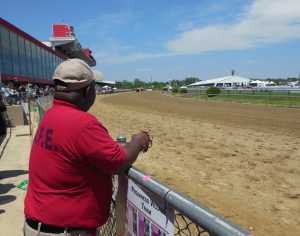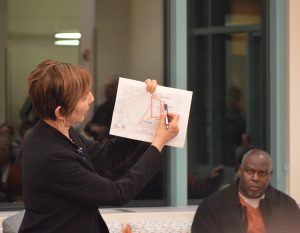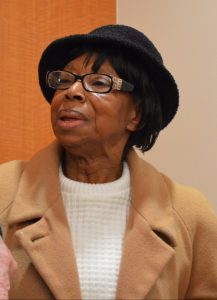Pimlico redevelopment forum offers options to doubtful neighbors
With the 143rd running of the Preakness Stakes just a few weeks away, area residents are still wondering what the future holds for the beleaguered track.
Will the storied race remain at Pimlico or be moved to Laurel?
What legislative options are on the table?
How would redevelopment impact traffic in the area?
Would the introduction of a hotel, retail businesses and an expansion of the LifeBridge medical campus be a boon to the community or simply bring more undesirable elements to an already troubled neighborhood?

Seeking answers to these and other questions has been the charge of a seven-member group called the Pimlico Revitalization Committee. On Tuesday night, before a crowd of about 100 concerned citizens, the committee held a public meeting to address the many longstanding issues surrounding the aging venue.
The forum (which was held in the cafeteria of the Mt. Washington Pediatric Hospital) was hosted by the Mt. Washington Improvement Association (MWIA).
Representing the Pimlico Revitalization Committee was Mt. Washington resident Jim Jacobs. Jacobs was joined by Delegate Samuel I. “Sandy” Rosenberg (D – District 41), Martha Nathanson from Sinai/LifeBridge Health, Marcus Pollock of Park Heights Renaissance, and Shelley Zimmerman standing in for Baltimore City Councilman Issac “Yitzy” Schleifer (D – District 5).
The meeting was the sixth such gathering to deal specifically with concerns about Pimlico.
No representatives from Maryland Racing, The Maryland Stadium Authority, or The Stronach Group were on hand.
Reporting on the progress of The Maryland Stadium Authority’s Pimlico Race Course Study, Jacobs said the first phase of the study was to establish the fact that Pimlico would remain intact for horse racing and the Preakness. The second phase is to consider that, for economic reasons, it is desirable to continue holding the Preakness at Pimlico.
“For economic development purposes, there is a desire to retain the racetrack at its present location. But there has to be development at the site that would support the track being able to stay there. The racetrack is not self-sustaining as it is. The Maryland Stadium Authority is spending several hundred thousand dollars on a study to see what they can do to support the track. They need input. They are getting lots of input, but they need to hear from the surrounding neighborhoods – critically from Mt. Washington – about what type of development should take place there,” said Jacobs.
Jacobs said the “Pimlico” tab on the MWIA website not only has links to all of the critical documents the association has reviewed, but also a box where residents may post comments.
Preakness Analogues To Hosting Super Bowl

Addressing the mood on the floor of the just-ended legislative session, Delegate Rosenberg told the crowd that lawmakers in Annapolis are well aware of the situation with Pimlico.
“In the last twelve months, it has become very clear that there is significant interest in redeveloping the site contiguous to the racetrack. Redeveloping the track itself for the Preakness spring meet and maybe adding twenty days of racing in the fall, like they do at Saratoga,” he said.
Rosenberg said there is interest from the for-profit community and interest from business community about doing something of a year-round nature on the infield.
“The second phase of the study that Jim (Jacobs) alluded to is very aware of the year-round opportunity for the track and for the site, so that the racetrack becomes – not the key – but part of a development that is a benefit to all the communities surrounding the track, and therefore to the city and the region.
“I think it’s appropriate to say the Preakness is analogous to having the Super Bowl every year. You get the tourist revenue, the local revenue from having the second jewel of the Triple Crown. If the track leaves, it would be a real blow. From what I’ve been told, it is far better to redevelop the site next to a redeveloped twenty-first century track. And Mayor Pugh is very strong on the idea that there will be major improvements outside of the race track property,” said Rosenberg.
Pollock said his words would be very brief, while noting that the development of Pimilco would be “huge” for the residents of Park Heights.
“We’re looking forward to seeing the shovels in the ground as it were,” said Pollock.

With a map in hand, Nathanson said that LifeBridge intends to develop a portion of the property it had originally acquired from the track for parking into a million square-foot ambulatory care center.
“We’d like to create a college campus-like feel for the LifeBridge Health campus at Sinai and Levindale. We want to create a walking path coming up Belvedere Ave. to the area where everybody parks,” said Nathanson.
Nathanson said the driving force behind the plan to build an ambulatory care center was a change in health care regulations intended to provide care to patients outside of a hospital setting.
“The initial building would be about 100,000 square feet, but there might be other projects which we or other developers might like to do.
“Before we proceed, there will be other meetings with the surrounding communities to elicit input. Once completed, the new facility would need to accommodate 600-800 people a day, with a potential growth to about 1000,” Nathanson said.
Speaking on behalf of Councilman Schleifer, Zimmerman said her boss definitely wants the Preakness to remain at Pimlico, but he is also excited about the prospect of the new development envisioned for the entire area.
“We’d really like to see something which will bridge the gap between all of the communities and attract investors,” said Zimmerman.
Some Area Residents Remain Doubtful
Opening the floor for questions, Rosenberg was asked if developers would be getting any money from the state?

“This will have to be a public and private partnership,” said Rosenberg. “One option (for funding) is an additional lottery. There are other tax options which would be beneficial to the Maryland Jockey Club in terms of the use of the property. There are also federal programs that are possibilities, such as the Opportunity Zone.”
While the questioning remained civil, one Park Heights resident observed that no one from either the Maryland Jockey Club or the Stronach Group was on hand to answer questions.
“These people don’t live around here. They don’t deal with the traffic or the smell (from the stables). For them, it’s all about the money. What is to prevent them from moving the Preakness out of Pimlico? I’ve heard both were in Laurel recently to talk about the big plans they have for the track down there.”
Rosenberg cited a 1986 provision in the Sunday Racing law, which was mandated by then-Gov. Schaefer, that stipulates that the Preakness must be run at Pimlico unless there is a disaster which would prevent the event from happening at the track.
“For the race to move, they must pass a law removing that provision from the code of Maryland,” said Rosenberg.
One long-time city resident questioned the commitment of Mayor Pugh to the neighborhoods around the track, noting that discussions about redevelopment “beyond the fence” have been going on for decades.
“We’ve heard this kind of talk from every mayor going back to the days of Tommy the Elder (former Mayor Thomas D’Alesandro Jr.) What gives you the assurance that (Pugh) means what she says?”
“She’s been in meetings,” said Rosenberg, “and she has made it clear she supports redevelopment south of the track. Don’t forget – she used to represent one of these communities, so she is very familiar with what is at stake.”

Committee member Evan Serpick somewhat tempered Rosenberg’s encouraging comments, saying he was told that, without the anchor of the Preakness at Pimlico, developers said they couldn’t be assured that they would get the funding they would need.
Though the meeting mostly centered on the hopeful potential for redevelopment of the Pimlico site, several area residents raised grave concerns about crime in the neighborhoods around the track.
The most impassioned voice of the night came from Park Heights resident Unell Dawson.
“Good people should not have to suffer because of the bad ones. We all have feelings, too. People don’t want the crime – they are scared. We hear about the track, but what about the other parts? When I moved into Pimlico, it was a nice neighborhood. But it has changed. My son was a homicide (victim).
“I cannot sell my house,” said an emotional Dawson. “I have nowhere to go.”
Pollock rose to respond to Dawson’s concerns, saying, “There are hundreds – or thousands – of people in Park Heights who want to do good. But we can’t do everything at once. We need to herd the cats. That’s what this effort is all about.”
City residents who were unable to attend the meeting are urged to leave comments on the MWIA website and to get in touch with their representatives.

Anthony C. Hayes is an actor, author, raconteur, rapscallion and bon vivant. A one-time newsboy for the Evening Sun and professional presence at the Washington Herald, Tony’s poetry, photography, humor, and prose have also been featured in Smile, Hon, You’re in Baltimore!, Destination Maryland, Magic Octopus Magazine, Los Angeles Post-Examiner, Voice of Baltimore, SmartCEO, Alvarez Fiction, and Tales of Blood and Roses. If you notice that his work has been purloined, please let him know. As the Good Book says, “Thou shalt not steal.”
